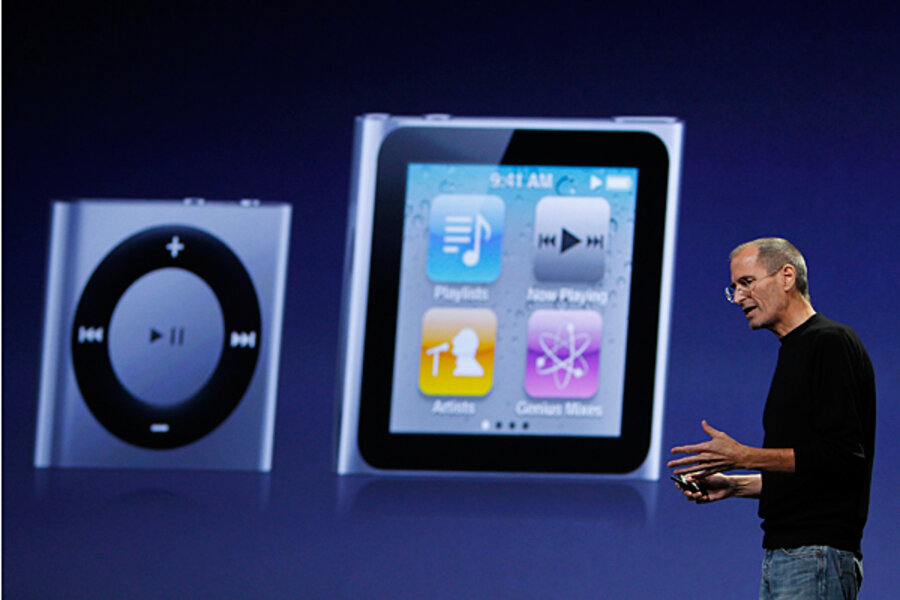Without Steve Jobs, can Apple's 'very strong bench' step up?
Loading...
| Los Angeles
Consumers and investors alike have swooned yet again at the prospect of Apple without Steve Jobs.
Monday, the founder and creative force behind the company that birthed not only the personal computer, but the iPod-iPhone-iPad revolution, announced that he is taking a second leave to focus on his health. In an e-mail to his employees, the on-again, off-again CEO stated that he “hopes” to be back.
The company’s stock took a hit Tuesday, but rallied by day’s end.
All of this continuing uncertainty leads to questions about what will happen when, either now or at some point in the future, Apple will have to move on without Mr. Jobs. How does a company survive the departure of its iconic creator?
Companies like Microsoft and Walt Disney offer clues both hopeful and skeptical. For Apple, it will involve understanding how Jobs made the company great.
Following Jobs's lead
“Jobs is fundamenatally mission-driven, not product-driven,” says David Wertheimer, CEO of the Entertainment Technology Center at the University of Southern California. “His great gift is to inspire this almost messianic sense of purpose that he is going to change the world.”
This breeds a culture of a great drive to innovate and look around the next corner. “He is perhaps singular in his ability to know what people want before they even know they want it,” adds Mr. Wertheimer, who worked with Jobs in the 1980s when the Apple founder was writing the operating-system code that now drives Apple’s most popular products.
Yet Apple, post-Jobs, might not be as impoverished as some reports might suggest. In spite of the public perception that the company rises and falls on the fortunes of its founder, “one thing you need to know about Apple is they have a very strong bench,” says Don Mayer, CEO of Small Dog Electronics, the third largest Apple retailer in the country.
After nearly two decades of working with Jobs, Mr. Mayer says that while it is true that Jobs is the visionary behind the company’s products, “visionaries spawn other visionaries."
The public mystique around Jobs is strong, adds Wertheimer, but it is important to note the depth of creativity and innovation surrounding the wide array of products coming from Apple – and what that depth says about the company. “There is no possible way Steve Jobs had enough time to touch every aspect of every product. So the fact that those products have so many great subtle differentiators shows there is a great group of innovative people doing work that is largely attributed to Jobs, because he inspires it,” he says.
Looking to history: Bill Gates and Walt Disney
Nonetheless, the company has dropped the ball when it comes to defining itself beyond Jobs – a task that must be done irrespective of the CEO’s health, notes Patrick Kerley from Levick Strategic Communications, a firm specializing in corporate crisis communications. The legend around Jobs and his close identification with the company served Apple well as it grew, but the firm does not seem to have taken seriously enough the question of its life without Jobs, he adds.
“It needs to send the message that the creative and technological processes that underlie the company are vital and continuing above and beyond one person,” he says. Firms such as longtime Apple rival, Microsoft, have already crossed this bridge. “Bill Gates is no longer involved with the day-to-day operations of his own creation,” points out Mr. Kerley, adding that the company is continuing to grow.
Yet other companies grown from a singular founder’s vision, such as the Walt Disney Company, offer more sobering lessons about the nature of creativity and innovation, says Paul Levinson, author of “New New Media.” He points to the company’s creative and financial lag in the immediate wake of Walt Disney’s departure, one that turned around during the 1980s.
But, he notes, “these days, Disney is in the business of producing mainstream entertainment, not world-changing innovation.”
Financial health vs. innovation
Indeed, the business world is full of examples of companies – form JP Morgan Chase to Ralph Lauren – that grew from the vision of a single creative spirit, says Terry Connelly, dean of the Ageno School of Business at Golden Gate University in San Francisco. An emphasis on good business practices is key. “The boards have to think in terms of financial stability going forward,” he adds.
But financial health is not the same as “mind-boggling new ideas,” points out Mr. Levinson.
This question of creativity versus paradigm-shifting innovation hangs over the future of Apple, says Simon Buckingham, founder and CEO off the online mobile application superstore, Appitalism.
A new management team can fairly easily come up with a new iteration of existing products, breathing life into the company for a few years, he says. But the big question is: “Who is going to come up with the product that resets the barriers and expectations and changes the behaviors of consumers,” he adds. With the departure of Jobs, “that’s where you will see the big void.”





